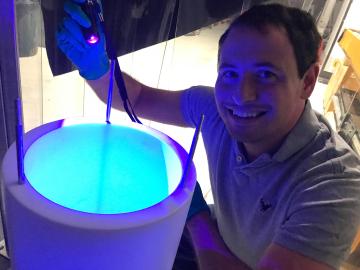
Filter News
Area of Research
- (-) Fusion and Fission (3)
- (-) Neutron Science (22)
- (-) Supercomputing (73)
- Advanced Manufacturing (4)
- Biological Systems (2)
- Biology and Environment (68)
- Computational Biology (1)
- Computational Engineering (2)
- Computer Science (6)
- Electricity and Smart Grid (3)
- Energy Science (84)
- Functional Materials for Energy (1)
- Fusion Energy (1)
- Materials (53)
- Materials for Computing (3)
- National Security (16)
- Nuclear Science and Technology (7)
- Quantum information Science (2)
- Sensors and Controls (1)
News Topics
- (-) Big Data (23)
- (-) Bioenergy (15)
- (-) Composites (2)
- (-) Grid (7)
- (-) Molten Salt (1)
- (-) Physics (18)
- (-) Summit (43)
- 3-D Printing/Advanced Manufacturing (12)
- Advanced Reactors (8)
- Artificial Intelligence (40)
- Biology (16)
- Biomedical (29)
- Biotechnology (2)
- Buildings (5)
- Chemical Sciences (11)
- Clean Water (2)
- Computer Science (99)
- Coronavirus (19)
- Critical Materials (4)
- Cybersecurity (9)
- Education (1)
- Energy Storage (17)
- Environment (30)
- Exascale Computing (27)
- Fossil Energy (2)
- Frontier (34)
- Fusion (23)
- High-Performance Computing (45)
- Hydropower (1)
- Isotopes (3)
- ITER (6)
- Machine Learning (17)
- Materials (28)
- Materials Science (34)
- Mathematics (2)
- Microscopy (9)
- Nanotechnology (20)
- National Security (8)
- Neutron Science (122)
- Nuclear Energy (33)
- Partnerships (4)
- Polymers (3)
- Quantum Computing (20)
- Quantum Science (30)
- Security (7)
- Simulation (19)
- Software (1)
- Space Exploration (5)
- Transportation (12)
Media Contacts

University of Pennsylvania researchers called on computational systems biology expertise at Oak Ridge National Laboratory to analyze large datasets of single-cell RNA sequencing from skin samples afflicted with atopic dermatitis.

ORNL and the Tennessee Valley Authority, or TVA, are joining forces to advance decarbonization technologies from discovery through deployment through a new memorandum of understanding, or MOU.

A study led by researchers at ORNL used the nation’s fastest supercomputer to close in on the answer to a central question of modern physics that could help conduct development of the next generation of energy technologies.

To explore the inner workings of severe acute respiratory syndrome coronavirus 2, or SARS-CoV-2, researchers from ORNL developed a novel technique.

A team of scientists led by the Department of Energy’s Oak Ridge National Laboratory and the Georgia Institute of Technology is using supercomputing and revolutionary deep learning tools to predict the structures and roles of thousands of proteins with unknown functions.

The U.S. Department of Energy’s Office of Science announced allocations of supercomputer access to 51 high-impact computational science projects for 2022 through its Innovative and Novel Computational Impact on Theory and Experiment, or INCITE, program.

Improved data, models and analyses from ORNL scientists and many other researchers in the latest global climate assessment report provide new levels of certainty about what the future holds for the planet

The Department of Energy’s Oak Ridge National Laboratory has licensed its award-winning artificial intelligence software system, the Multinode Evolutionary Neural Networks for Deep Learning, to General Motors for use in vehicle technology and design.

The U.S. Department of Energy’s Innovative and Novel Computational Impact on Theory and Experiment, or INCITE, program is seeking proposals for high-impact, computationally intensive research campaigns in a broad array of science, engineering and computer science domains.

The COHERENT particle physics experiment at the Department of Energy’s Oak Ridge National Laboratory has firmly established the existence of a new kind of neutrino interaction.


